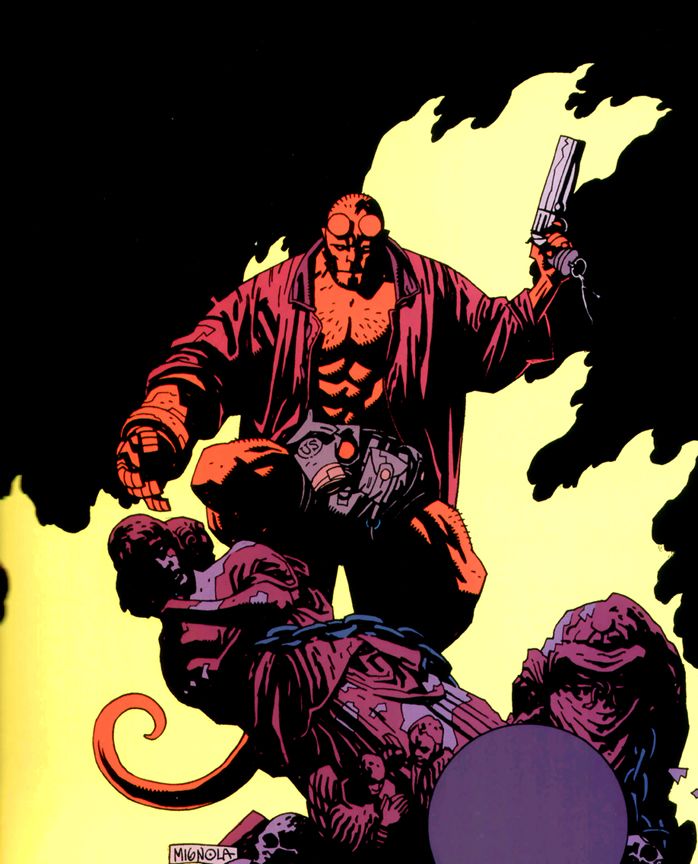 |
| Mike Mignola (1994) |
After two decades and so many miniseries and titles it can be hard to know where to start with Hellboy. It doesn't help matters Mignola's chronology jumped around depending on whatever inspired him to write and draw a particular story. In one book, Hellboy could be in Ireland in 1959 or 1961, then show up in Japan in 1967 for the next, then guest star in an issue of The Goon telling the story about Japan. Or something like that. Working it out this way, Mignola and his later collaborators have built a massive narrative spanning decades, continents and even the galaxy, with characters dying and other joining, menaces burbling up from the background, others springing full-blown into the foreground plot.
From his earliest days fighting un-frozen Nazis and their spiritual leader Rasputin-- yes, the historical Rasputin, the one Prince Felix Yusupov, Grand Duke Dmitri Pavlovich and some concerned friends poisoned, shot, beat and drowned in 1916-- to various creatures from European myth, with an underpinning of H.P. Lovecraft, Hellboy now inhabits a sharply defined world with all kinds of incidents and epics. So how do you jump into this world?
Sorry, I'm not much help there. I'm not a continuity junkie or obsessed with minutia. All I ask is whatever story I'm reading to be internally consistent. And I tend to prefer Mignola's moody, sometimes peculiarly random one-offs with Hellboy himself to the longer apocalyptic tales generally starring the BPRD cast (althought these are good, too). That's why I say, "Don't worry about a reading order with Hellboy." My advice is just buy the Seed of Destruction collection and start there. Move on to whatever story catches your fancy.
In short, you must do as you see fit.
For me, Hellboy pushes a number of buttons. Let's examine four of them in detail. Mignola's art is the first. I love bold, heavily stylized art, the kind where you say, "Now there's a nice drawing, just the essentials" rather than take in something that looks like it was traced from a still frame out of a movie, or a swimsuit magazine. Mignola's work has become more essentialist and geometrical over time and that's my bag.
The second is my love of the weird and fantastic. Since earliest childhood, I've read books about cryptid animals, UFOs, alternate dimensions, the Bermuda Triangle, ghosts, urban legends and the like. I've always loved stories where teams of people investigate the unknown and come to grief, from Kolchak to Venkman, Stantz, Spengler and Zeddmore to Mulder and Scully to Hellboy and company. I'm a friend to them all.
Folklore and myth make the third. Mignola draws heavily on European traditions and Lovecraft, but he has broken with this on a few memorable occasions. Two are team-ups with horror art legend Richard Corben-- Makoma, informed by African folktales and The Crooked Man, set in the Appalachian Mountains of the good ol' U.S. of A. Both are lovely and strange. How can anyone not read these?
And the fourth is a specific story. As an ex-pat living in Japan, "Heads," set in Kyoto, is a lot of fun in a very personal way. Mignola claims in his introduction to the story not to know a whole lot about Japan. Yeah, but his art, as influenced by Alphonse Mucha, who himself drew on Japanese ukiyo-e and their extremely linear forms as it is by European woodcuts, Jack Kirby or P. Craig Russell, makes him particularly apt for this kind of material. I wish Hellboy would revisit Japan sometime in the near future. If Mignola or any of his collaborators need some first hand experience and reference-- or just want to hang out while doing a research trip-- well, now, I know just the blogger to volunteer his services!

No comments:
Post a Comment